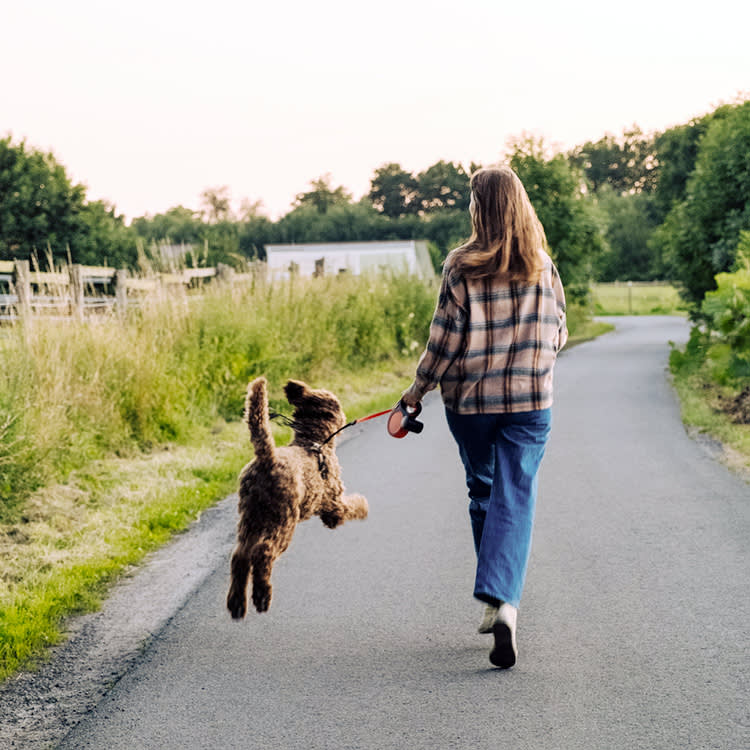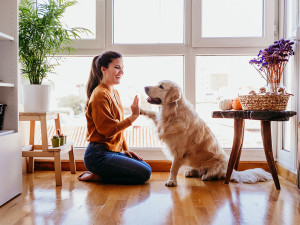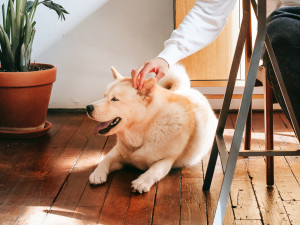How to Make On-Lead Dog Walks More Exciting
There are plenty of ways to spice them up

share article
The daily walkopens in a new tab with your pet is one of the greatest pleasures of dog ownership. Our furry friends benefit from the exercise and the interaction with a new environment, and you benefit from getting outdoors and moving your body, too. Watching them race around the park or roam across fields or forest can be a joyful thing to see, but dogs can’t always be given the freedom we’d like them to have, and so sometimes you might have to keep them on the leadopens in a new tab.
On-lead walking has a bit of a bad rep among some. You’ve probably overheard a dog owner say that “they didn’t get a good walk because they had to stay on the lead”, or perhaps you’ve even thought so yourself. But on-lead walks aren’t as boring as you might think, and there are plenty of ways to spice them up and offer your dog even more reward than careering about in the park might give.
Is off-lead walking better for our dogs?
“Of course, off-lead is lovely for dogs,” says certified behaviourist Emma Barnett of So Help Me Dogopens in a new tab. “It’s what they’re meant to be doing. They’re meant to have freedom. They’re meant to have a choice about where they go and what they sniff, and to go at their own pace. Off-lead would always be more preferable for a dog.”
But there are situations where on-lead walks are necessary. Dog anxiety expert Yasmin El-Saieopens in a new tab says it’s about safety, especially in built-up areas like cities: “Some dogs are trustworthy and won’t stray from the path, but you never know what might spook a dog.” She speaks from experience, as she’s seen dogs run out in front of her car in the middle of London before.
It also depends on what kind of dog you have, says Emma. “Sighthounds will be alert to everything in the environment and may go off like a rocket to catch, chase and kill a rabbit.” If that’s the case, on-lead walksopens in a new tab in the wild might be best, and off-lead chasing should be left for the garden at home or a private hire field.
Why would I need to walk my dog on a lead?
There are myriad reasons for keeping your dog on a lead during a walk. Your dog might be in season, for example, and to keep it from experiencing any unwanted pregnancies, you might need to walk them on the lead in quieter places to avoid any intact male dogs. Perhaps you’re walking your dog in the dark, or maybe you live in a built-up area and it’s not safe to walk them off-lead. Dogs in recovery after operations or those with injuries often have to be walked on a lead for a period of time, and banned breeds such as the XL Bullyopens in a new tab are now required by law to be leashed in public at all times.
Finally, if your dog has an unreliable recallopens in a new tab, on-lead walks might be the only way you can walk them safely without putting them, other dogs, or members of the public, at risk. Ultimately, while off-lead might be your preference – and your dog’s preference – on-lead walking is hugely important for your dog’s safety.
Can on-lead walks ever be exciting for dogs?
It’s a huge resounding yes from Emma, who regularly walks her own dog Alfie on the lead. “I think it’s more about changing our mindsets as owners. We are hardwired to think that a dog must have an off-lead walk in order for it to be enjoyable and to expend all its energy. But some of our most tiring walks for Alfie have been at night when he’s on the lead and we go on a sniffari.”
This ‘sniffari’ Emma talks about is essentially embracing the dog’s instinct for sniffingopens in a new tab. She says that around 20 minutes of sniffing can be just as rewarding as 90 minutes of running around, and so following your dog’s nose is often the way forwards for on-lead walking. If they want to sniff a lamppost for five whole minutes, let them. If they feel the need to spend half the walk on one small patch of grass, allow it. They do this to find out who’s been nearby recently, and sniffing out other dogs’ scent markings is hugely enjoyable for them.
“It’s like us scrolling through Instagram or reading a paper,” says Emma. “It’s information gathering and information processing, and it’s telling them about what’s going on in the world. It’s pleasurable for them.”
You can create your own ‘sniffari’ by introducing food – perhaps dry food or some high-value treatsopens in a new tab – and throwing it on to the ground or into the grass for your dog to snuffle about, too. “This will activate something in the brain called the seeking system,” says Emma. “It’s about the anticipation of reward, and that’s fuelled by dopamine. The moment we start to do sniffing to find food in the grass, the anticipation of finding that food is flooding the system with dopamine.” As we all know, dopamine is the molecule that gives feelings of pleasure and satisfaction, so this can be highly enjoyable for your dog.
Turning your on-lead walk into a training sessionopens in a new tab can be equally rewarding and tiring for your dog, says Yasmin. “Start by teaching your dog to walk to heel and make it really fun with treats. Most dogs like to work, so you could just practise getting their attention and rewarding eye contact, or you could teach them to pause when you pause, and continue walking when you do.”
Speaking of work, most of our dogs were bred for specific jobs and some are still used for them, such as herding and retrieving. “Look at what your dog did as a job and see if you can recreate that during an on-lead walk.” This might mean using a longline to do some retrieving, or laying a scent so they can do some tracking.
Finally, dog walker Rhian Deaconopens in a new tab suggests walking your pet with other dogs to enrich their on-lead adventures. “As humans we often forget that dogs communicate through several different ways, such as barking, sniffing and body language. Being in the company of other dogs allows your dog to engage in all of these behaviours which can be mentally stimulating and satisfying for them as well.”

Lottie Gross
Lottie Gross is a freelance writer specialising in dogs and travel. She has been travelling the UK and Europe with her Manchester Terrier Arty since 2021 and is the author of several dog travel guides, including Dog-Friendly Weekends published by Bradt and Dog Days Outopens in a new tab by Bloomsbury. She writes dog-friendly travel pieces and general travel stories for The Telegraph, The Times, Guardian, Independent and The i, and is a dog-product tester for Expert Reviews.
Related articles
![A woman holding a dogs paw and smiling.]() opens in a new tab
opens in a new tabNine Useful Tricks to Teach Your Dog
Go beyond the basics
![Stylish woman sitting on a bench with her Boston Terrier dog.]() opens in a new tab
opens in a new tabHere’s Why Your Dog Is Terrified of New People
And how to change it
![Unrecognizable man sitting at desk petting his dog]() opens in a new tab
opens in a new tabHow to Stroke a Dog – Yes, You Do Need Lessons
There’s a difference between being affectionate and being annoying
![Owner walking two Dalmatians downtown]() opens in a new tab
opens in a new tabHow To Stop a Dog From Pulling on the Lead
Dog trainer Karen B London promises you’re not doomed to be pulled down the street forever
![Dog walker crossing a street with three dogs]() opens in a new tab
opens in a new tabHow to Prepare Your Pup For Daycare and Dog Walkers
Set your pup up for success
![Dachshund dog freezing on a rock during a walk]() opens in a new tab
opens in a new tabWhy Does My Dog Turn Into a Statue on Walks?
Suddenly, the pavement has some new installation art: your frozen dog





